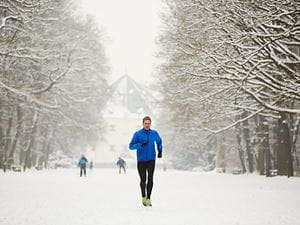
Shutterstock.com
Winter is normally the time when most people, including professional runners, pack up their running kits and store them until the warmer seasons are back again. This is because a lot of people find running in the cold unbearable, but this is only because they don’t have any idea of how to enjoy running when it is cold outside. If you have always avoided running when it is cold outside or you have been doing so with a lot of discomforts, here are some of the best tips you can employ so that you enjoy every step you take when running outside, irrespective of how biting the cold may be.
Know how to dress for running when it is cold outside.
One of the challenges most people face when running in the cold is how to dress properly. The majority are fond of wearing layers for them to keep the cold away, but once they start running, they begin to sweat and overheat, thus making the running more uncomfortably. When it comes to dressing for running in the cold, the rule of thumb is to dress as if it is 10 degrees warmer outside.This is to account for the increase in temperature your body will realize once you start running. You may feel the cold in the first few minutes into the run, but as you progress, your body will begin to generate internal heat, and you will appreciate that you didn’t go heavy on your dressing.
Avoid large open spaces on windy days.
The last experience you want to have when running in cold weather is to expose yourself to the wind. Wind and cold will make it difficult for you to breath, thus interfering with your overall running experience. If you have to venture out on a cold windy day for your run, be sure to avoid large open spaces and restrict yourself to relatively enclosed spaces, preferably between tall buildings. This is how to avoid the painful windburns and enjoy your running even when it is cold outside.Take good care of your extremities.
Your extremities are one of the body parts you need to keep very warm when running in cold weather. When it is too cold, or under freezing temperatures, most of the blood flow within your body will be restricted within your core, implying that very little blood will be reaching your extremities like fingers, toes, and your face. They will, therefore, be prone to lots of cold and frostbites. To give them the protection they need so that you can get the comfort you desire, it is advisable to cover your face with a light breathable mask to avoid coughs and frostbites.You will also need the right gloves for your hands, preferably a thin inner pair made from wicking materials and a thicker and heavier one as the outer pair. For your toes, a pair of socks with the ability to wick sweat wetness and keep your feet warm and dry would be highly recommended.
Warm up properly indoors.
Dynamic warmups for between 15 and 20 minutes are highly encouraged before you venture out running on a cold day. Proper indoor warm-up is necessary to get your heart rate up, increase the body temperature and get the blood flowing to all parts of your body before you hit the road. This will, in turn, get your entire body, especially your muscle ready for the tough task ahead. Some of the warm-up you can think about include walking lunges, leg swings, and inchworms. These will fire up your muscles quickly and get your entire body ready for the run before you step out of your door.Get the right shoes.
A common complaint most people have when running when it is cold outside is their foot going completely numb. Your choice of socks may be partly responsible for this problem, but it may be largely caused by the wrong choice of running shoes. The shoes you wear should fit comfortably, not too tight or too small and the socks you have should also be able to wick away the sweat. Remember, the shoes should also have a good grip to prevent you from slipping and getting an injury on the wet tracks or in the snow.Be visible to other road users.
If you are running during winter, then visibility is likely to be hampered, especially when snow is falling. Consequently, it is vital to be seen by other road users to avoid unnecessary accidents and injuries. A good way to increase visibility under such conditions is to wear a reflective, fluorescent gear and if necessary, don’t be afraid to light yourself like a Christmas tree. If you are running late in the evening when the visibility may even be hampered further, then it is okay to use a headlamp or run with a flashlight so that you can see where you are going and also make it possible for other road users to see you.Stay hydrated.
Since it is cold, it may be tempting to avoid the need for hydration simply because there is no hot sun to make you sweat and lose a lot of water. But this is a very misleading misconception. Staying hydrated is just as important in cold weather as it is important in the summer. One thing you have to know is that cold seasons are usually drier and for runners, it is easy to overlook the amount of sweating that is actually going on. It is therefore important to keep yourself diligently hydrated by taking the recommended amount of fluids. Whether or not you feel thirsty, it is imperative that you take plenty of water before and after running when it is cold outside.Change quickly after the run.
Your core body temperature will drop drastically when you stop running, and to avoid suffering the lingering chills after the run, be sure to change into warm clothes, right from your head to your toe immediately after the run. For ladies, the damp sports bra must be removed immediately, and for men, the dump layers must also be removed. It is also ideal to drink something hot to help in maintaining your core body temperature immediately after you come in from running.Running when it is cold outside is never easy, and not all athletes, not even the most decorated ones will stick to their regular regimes when the snow comes falling. But it should be understood that the only difference between running in winter and summer is just the temperature. When it is cold, you will need to adapt to the cold conditions so that you stay comfortable outdoors. Our bodies are designed in such a way that they can always adapt to the external temperatures and the more physical activity we engage in, the more internal heat is generated. This is why it is vital to factor in how you dress before venturing to run when it is cold outside.
Other than the dressing, you also need to keep an account of certain other essential factors, which if ignored, then you can end up with a nasty experience during that session. For instance, it is imperative to not expose yourself to the winds. This will have a direct impact on your performance, and will not only slow you down, but can also affect how you breathe and your overall health. This is why running in enclosed spaces is highly recommended in cold weathers.
The final aspect about running in the cold you should consider is proper warm up and warm down before and after running respectively. Through proper warm up, you will prepare your entire body system for the run, and as usual, it is imperative to warm down after every workout. Without warming up dynamically, your muscles may get shocked following sudden exposure to the cold and the result wouldn’t be a great run.
Just know that running in the cold can be both fun and challenging, depending on how you approach it. If you use the tips given above, you will be looking forward to running every single day, irrespective of how chilling it is outside!

